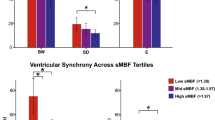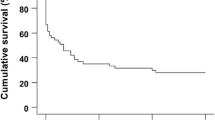Abstract
Background
Nonischemic dilated cardiomyopathy (NIDCM) is associated with left ventricular remodeling, hypertrophy, and mitochondrial metabolic abnormalities in vitro. We evaluated the hypothesis that energy supply, as judged by the rate of myocardial oxidative metabolism, is inadequate to meet oxygen demand in patients with NIDCM compared with normal subjects.
Methods and Results
We used positron emission tomography to determine the myocardial carbon 11 acetate decay rate (kmono) as an index of energy supply, and we compared kmono with the rate-pressure product (RPP) as an index of metabolic demand in 7 patients with NIDCM and 7 normal subjects. The mean kmono value (SEM) was 0.060 ± 0.006 min-1 in NIDCM patients versus 0.054 ± 0.002 in normal subjects (P = not significant). The RPP was 9949 ± 931 beats/min · mm Hg in NIDCM patients and 6521 ± 476 in normal subjects (P = .007). The relationship of kmono to this index of demand (kmono/RPP) was 6.2 x 10-6 in NIDCM patients but was 8.5 x 10-6 in normal subjects (P = .003). Thus RPP, as an index of myocardial oxygen demand, was poorly matched by the rate of oxidative metabolism in those patients with NIDCM. The kmono was closely related to RPP in normal subjects (r = 0.83, P = .02) but not in NIDCM patients. Furthermore, there was no significant relationship between kmono and wall stress as another index of oxygen demand.
Conclusions
These results are consistent with a mitochondrial metabolic abnormality in heart failure. This metabolic mismatch detected by positron emission tomography may contribute to the pathophysiology of congestive heart failure and left ventricular remodeling.
Similar content being viewed by others
References
Lee DS, Austin PC, Rouleau JL, Liu PP, Naimark D, Tu JV. Predicting mortality among patients hospitalized for heart failure: derivation and validation of a clinical model. JAMA 2003;290: 2581–7.
Konstam MA, Rousseau MF, Kronenberg MW, Udelson JE, Melin J, Stewart D, et al. Effects of the angiotensin converting enzyme inhibitor, enalapril, on the long-term progression of left ventricular dysfunction in patients with heart failure. Circulation 1992;86: 431–8.
Pfeffer JM, Pfeffer MA, Mirsky I, Braunwald E. Regression of left ventricular hypertrophy and prevention of left ventricular dysfunction by captopril in the spontaneously hypertensive rat. Proc Natl Acad Sci USA 1982;79:3310–4.
Quigley AF, Kapsa RM, Esmore D, Hale G, Byrne E. Mitochondrial respiratory chain activity in idiopathic dilated cardiomyopathy. J Card Fail 2000;6:47–55.
Sharov VG, Goussev A, Lesch M, Goldstein S, Sabbah HN. Abnormal mitochondrial function in myocardium of dogs with chronic heart failure. J Mol Cell Cardiol 1998;30:1757–62.
Sharov VG, Todor AV, Silverman N, Silverman N, Goldstein S, Sabbah HN. Abnormal mitochondrial respiration in failed human myocardium. J Mol Cell Cardiol 2000;32:2361–7.
Ide T, Tsutsui H, Kinugawa S, Utsumi H, Kang D, Hattori N, et al. Mitochondrial electron transport complex I is a potential source of oxygen free radicals in the failing myocardium. Circ Res 1999;85: 357–63.
Suga H, Hisano R, Goto Y, Yamada O, Igarashi Y. Effect of positive inotropic agents on the relation between oxygen consumption and systolic pressure volume area in canine left ventricle. Circ Res 1983;53:306–18.
Wolpers HG, Buck A, Nguyen N, Marcowitz PA, Armstrong WF, Starling MR, et al. An approach to ventricular efficiency by use of carbon 11-labeled acetate and positron emission tomography. J Nucl Cardiol 1994;1:262–9.
De Marco T, Chatterjee K, Rouleau JL, Parmley WW. Abnormal coronary hemodynamics and myocardial energetics in patients with chronic heart failure caused by ischemic heart disease and dilated cardiomyopathy. Am Heart J 1988;115:809–15.
Monrad ES, Baim DS, Smith HS, Lanoue A, Brauwald E, Grossman W. Effects of milrinone on coronary hemodynamics and myocardial energetics in patients with congestive heart failure. Circulation 1985;71:972–9.
Graham TP Jr, Covell JW, Sonnenblick EH, Ross J Jr, Braunwald E. Control of myocardial oxygen consumption: relative influence of contractile state and tension development. J Clin Invest 1968; 47:375–85.
Braunwald E. 50th anniversary historical article. Myocardial oxygen consumption: the quest for its determinants and some clinical fallout. J Am Coll Cardiol 1999;34:1365–8.
Beanlands RS, Bach DS, Raylman R, Armstrong WF, Wilson V, Montieth M, et al. Acute effects of dobutamine on myocardial oxygen consumption and cardiac efficiency measured using carbon- 11 acetate kinetics in patients with dilated cardiomyopathy. J Am Coll Cardiol 1993;22:1389–98.
Beanlands RS, Armstrong WF, Hicks RJ, Nicklas J, Moore C, Hutchins GD, et al. The effects of afterload reduction on myocardial carbon 11-labeled acetate kinetics and noninvasively estimated mechanical efficiency in patients with dilated cardiomyopathy. J Nucl Cardiol 1994;1:3–16.
Katz AM. Is the failing heart energy depleted? Cardiol Clin 1998;16:633–44.
Di Carli MF, Tobes MC, Mangner T, Levine AB, Muzik O, Chakroborty P, et al. Effects of cardiac sympathetic innervation on coronary blood flow. N Engl J Med 1997;336:1208–15.
Di Carli MF, Bianco-Batlles D, Landa ME, Kazmers A, Groehn H, Muzik O, et al. Effects of autonomic neuropathy on coronary blood flow in patients with diabetes mellitus. Circulation 1999;100:813–9.
Muzik O, Beanlands RS, Hutchins GD, Mangner TJ, Nguyen N, Schwaiger M. Validation of nitrogen-13-ammonia tracer kinetic model for quantification of myocardial blood flow using PET. J Nucl Med 1993;34:83–91.
Brown M, Marshall DR, Sobel BE, Bergmann SR. Delineation of myocardial oxygen utilization with carbon-11-labeled acetate. Circulation 1987;76:687–96.
Brown MA, Myears DW, Bergmann SR. Validity of estimates of myocardial oxidative metabolism with carbon-11 acetate and positron emission tomography despite altered patterns of substrate utilization. J Nucl Med 1989;30:187–93.
Armbrecht JJ, Buxton DB, Brunken RC, Phelps ME, Schelbert HR. Regional myocardial oxygen consumption determined noninvasively in humans with [1-11C]acetate and dynamic positron tomography. Circulation 1989;80:863–72.
Armbrecht JJ, Buxton DB, Schelbert HR. Validation of [1-11C]acetate as a tracer for noninvasive assessment of oxidative metabolism with positron emission tomography in normal, ischemic, postischemic, and hyperemic canine myocardium. Circulation 1990;81:1594–605.
Di Carli MF, Prcevski P, Singh TP, Janisse J, Ager J, Muzik O, et al. Myocardial blood flow, function, and metabolism in repetitive stunning. J Nucl Med 2000;41:1227–34.
Byrd BF III, Finkbeiner W, Bouchard A, Silverman NH, Schiller NB. Accuracy and reproducibility of clinically acquired twodimensional echocardiographic mass measurements. Am Heart J 1989;118:133–7.
Reichek N, Wilson J, St John Sutton M, Plappert TA, Goldberg S, Hirshfeld JW. Noninvasive determination of left ventricular endsystolic stress: validation of the method and initial application. Circulation 1982;65:99–108.
Byrd BF III, Wahr D, Wang YS, Bouchard A, Schiller NB. Left ventricular mass and volume/mass ratio determined by twodimensional echocardiography in normal adults. J Am Coll Cardiol 1985;6:1021–5.
Neglia D, Michelassi C, Trivieri MG, Sambuceti G, Giorgetti A, Pratali L, et al. Prognostic role of myocardial blood flow impairment in idiopathic left ventricular dysfunction. Circulation 2002; 105:186–93.
van den Heuvel AF, van Veldhuisen DJ, van der Wall EE, Blanksma PK, Siebelink HM, Vaalburg WM, et al. Regional myocardial blood flow reserve impairment and metabolic changes suggesting myocardial ischemia in patients with idiopathic dilated cardiomyopathy. J Am Coll Cardiol 2000;35:19–28.
Weismuller S, Czernin J, Sun KT, Fung C, Phelps ME, Schelbert HR. Coronary vasodilatory capacity is impaired in patients with dilated cardiomyopathy. Am J Card Imaging 1996;10:154–62.
Bengel FM, Permanetter B, Ungerer M, Nekolla S, Schwaiger M. Non-invasive estimation of myocardial efficiency using positron emission tomography and carbon-11 acetate-comparison between the normal and failing human heart. Eur J Nucl Med 2000;27:319–26.
Heineman FW, Balaban RS. Control of myocardial oxygen consumption by work. In: Fozzard HA, Haber E, Jennings RB, Katz AM, Morgan HE, editors. The heart and cardiovascular system. Scientific foundations. 2nd ed. New York: Raven Press; 1991. p. 1641–56.
Henes CG, Bergmann SR, Walsh MN, Sobel BE, Geltman EM. Assessment of myocardial oxidative metabolic reserve with positron emission tomography and carbon-11 acetate. J Nucl Med 1989;30:1489–99.
Beanlands RS, Nahmias C, Gordon E, Coates G, deKemp R, Firnau G, et al. The effects of beta(1)-blockade on oxidative metabolism and the metabolic cost of ventricular work in patients with left ventricular dysfunction: a double-blind, placebo-controlled, positron-emission tomography study. Circulation 2000;102:2070–5.
Agostini D, Iida H, Takahashi A, Tamura Y, Henry AM, Ono Y. Regional myocardial metabolic rate of oxygen measured by 02-15 inhalation and positron emission tomography in patients with cardiomyopathy. Clin Nucl Med 2001;26:41–9.
Sabbah HN, Sharov V, Riddle JM, Kono T, Lesch M, Goldstein S. Mitochondrial abnormalities in myocardium of dogs with chronic heart failure. J Mol Cell Cardiol 1992;24:1333–47.
Unverferth DV, Leier CV, Magorien RD, Croskery R, Svirbely JR, Kolibash AJ, et al. Improvement of human myocardial mitochondria after dobutamine: a quantitative ultrastructural study. J Pharmacol Exp Ther 1980;215:527–32.
Unverferth DV, Lee SW, Wallick ET. Human myocardial adenosine triphosphatase activities in health and heart failure. Am Heart J 1988;115:139–46.
Bashore TM, Magorien DJ, Letterio J, Shaffer P, Unverferth DV. Histologic and biochemical correlates of left ventricular chamber dynamics in man. J Am Coll Cardiol 1987;9:734–42.
Owen P, Dennis S, Opie LH. Glucose flux rate regulates onset of ischemic contracture in globally underperfused rat hearts. Circ Res 1990;66:344–54.
Cunningham MJ, Apstein CS, Weinberg EO, Vogel WM, Lorell BH. Influence of glucose and insulin on the exaggerated diastolic and systolic dysfunction of hypertrophied rat hearts during hypoxia. Circ Res 1990;66:406–15.
Vanoverschelde JL, Janier MF, Bakke JE, Marshall DR, Bergmann SR. Rate of glycolysis during ischemia determines extent of ischemic injury and functional recovery after reperfusion. Am J Physiol 1994;267:H1785–94.
Roberts JT, Wearn JT. Quantitative changes in the capillarymuscle relationship in human hearts during normal growth and hypertrophy. Am Heart J 1941;21:617–33.
Anversa P, Olivetti G, Melissari M, Loud AV. Stereological measurement of cellular and subcellular hypertrophy and hyperplasia in the papillary muscle of adult rat. J Mol Cell Cardiol 1980;12:781–95.
Stolen KQ, Kemppainen J, Kalliokoski KK, Karanko H, Toikka J, Janatuinen T, et al. Myocardial perfusion reserve and peripheral endothelial function in patients with idiopathic dilated cardiomyopathy. Am J Cardiol 2004;93:64–8.
Corral-Debrinski M, Stepien G, Shoffner JM, Lott MT, Kanter K, Wallace DC. Hypoxemia is associated with mitochondrial DNA damage and gene induction. Implications for cardiac disease. JAMA 1991;266:1812–6.
Schultheiss HP. Disturbance of the myocardial energy metabolism in dilated cardiomyopathy due to autoimmunological mechanisms. Circulation 1993;87(Suppl):IV43–8.
Sawyer DB, Colucci WS. Mitochondrial oxidative stress in heart failure. “Oxygen wastage” revisited. Circ Res 2000;86:119–20.
Beer M, Syefarth T, Sandstede J, Landschutz W, Lipke C, Kostler H, et al. Absolute concentrations of high-energy phosphate metabolites in normal, hypertrophied, and failing human myocardium measured noninvasively with 31P-SLOOP magnetic resonance spectroscopy. J Am Coll Cardiol 2002;40:1267–74.
Neubauer S, Horn M, Cramer M, Harre K, Newell JB, Peters W, et al. Myocardial phosphocreatine-to-ATP ratio is a predictor of mortality in patients with dilated cardiomyopathy. Circulation 1997;96:2190–6.
Soto PF, Herrero P, Kates AM, Dence CS, Ehsani AA, Davila-Roman V, et al. Impact of aging on myocardial metabolic response to dobutamine. Am J Physiol Heart Circ Physiol 2003;285:H2158–64.
Owen P, Dennis S, Opie LH. Glucose flux rate regulates onset of ischemic contracture in globally underperfused rat hearts. Circ Res 1990;66:344–54.
Buck A, Wolpers HG, Hutchins GD, Savas V, Mangner TJ, Nguyen N, et al. Effect of carbon-11-acetate recirculation on estimates of myocardial oxygen consumption by PET. J Nucl Med 1991;32:1950–7.
Stolen KQ, Kemppainen J, Ukkonen H, Kalliokoski KK, Luotolahti M, Lehikoinen P, et al. Exercise training improves biventricular oxidative metabolism and left ventricular efficiency in patients with dilated cardiomyopathy. J Am Coll Cardiol 2003;41:460–7.
Sun KT, Yeatman LA, Buxton DB, Chen K, Johnson JA, Huang SC, et al. Simultaneous measurement of myocardial oxygen consumption and blood flow using [1-carbon-11]acetate. J Nucl Med 1998;39:272–80.
Gropler RJ. Noninvasive measurements of myocardial oxygen consumption-can we do better? J Am Coll Cardiol 2003;41:468–70.
Eichhorn EJ, Heesch CM, Barnett JH, Alvarez LG, Fass SM, Grayburn PA, et al. Effect of metoprolol on myocardial function and energetics in patients with nonischemic dilated cardiomyopathy: a randomized, double-blind, placebo-controlled study. J Am Coll Cardiol 1994;24:1310–20.
Author information
Authors and Affiliations
Corresponding author
Additional information
Supported in part by a grant from Sanofi-Synthelabo, New York, NY.
Rights and permissions
About this article
Cite this article
Kronenberg, M.W., Cohen, G.I., Leonen, M.F. et al. Myocardial oxidative metabolic supply-demand relationships in patients with nonischemic dilated cardiomyopathy. J Nucl Cardiol 13, 544–553 (2006). https://doi.org/10.1016/j.nuclcard.2006.04.002
Received:
Accepted:
Issue Date:
DOI: https://doi.org/10.1016/j.nuclcard.2006.04.002




